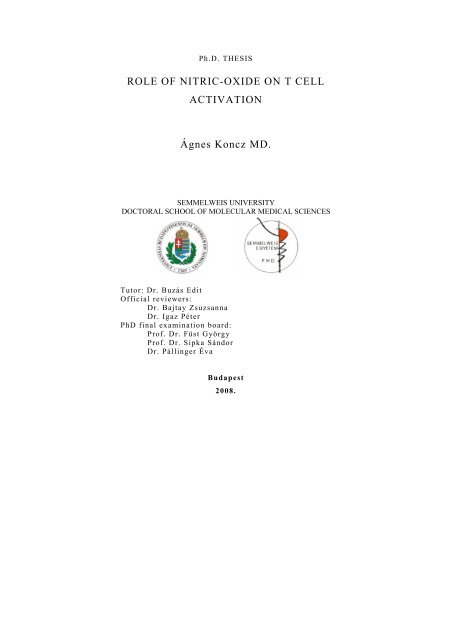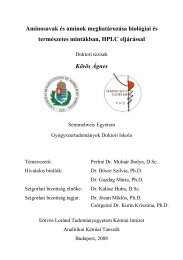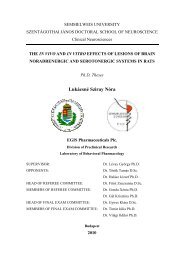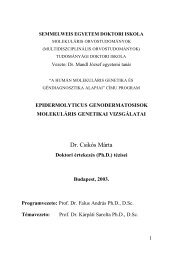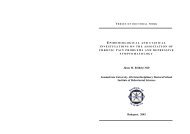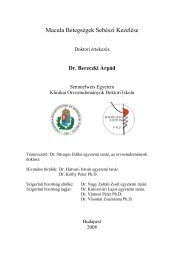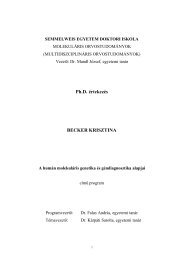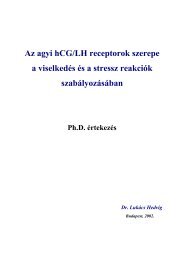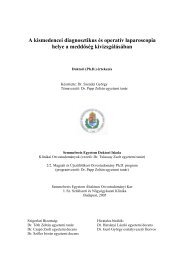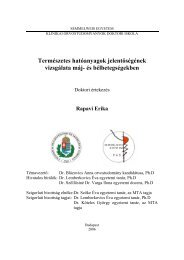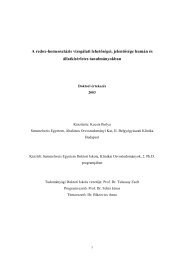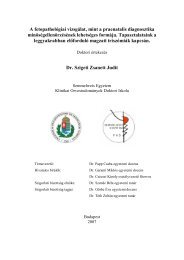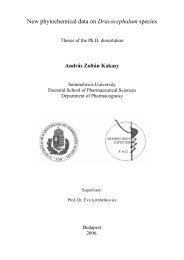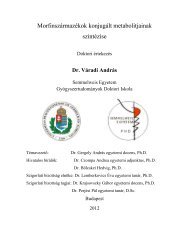ROLE OF NITRIC-OXIDE ON T CELL ACTIVATION Ágnes Koncz MD.
ROLE OF NITRIC-OXIDE ON T CELL ACTIVATION Ágnes Koncz MD.
ROLE OF NITRIC-OXIDE ON T CELL ACTIVATION Ágnes Koncz MD.
You also want an ePaper? Increase the reach of your titles
YUMPU automatically turns print PDFs into web optimized ePapers that Google loves.
Ph.D. THESIS<br />
<strong>ROLE</strong> <strong>OF</strong> <strong>NITRIC</strong>-<strong>OXIDE</strong> <strong>ON</strong> T <strong>CELL</strong><br />
ACTIVATI<strong>ON</strong><br />
<strong>Ágnes</strong> <strong>Koncz</strong> <strong>MD</strong>.<br />
SEMMELWEIS UNIVERSITY<br />
DOCTORAL SCHOOL <strong>OF</strong> MOLECULAR MEDICAL SCIENCES<br />
Tutor: Dr. Buzás Edit<br />
Official reviewers:<br />
Dr. Bajtay Zsuzsanna<br />
Dr. Igaz Péter<br />
PhD final examination board:<br />
Prof. Dr. Füst György<br />
Prof. Dr. Sipka Sándor<br />
Dr. Pállinger Éva<br />
Budapest<br />
2008.
Inroduction<br />
The signaling networks that mediate activation,<br />
proliferation, or programmed cell death of T lymphocytes are<br />
dependent on complex redox and metabolic pathways.<br />
TCR signaling is initiated when antigen presented by major<br />
histocompatibility complex (MHC) molecules binds to the TCR<br />
complex. Signaling via the TCR has been extensively studied using<br />
anti-TCR or anti-CD3 monoclonal antibodies, which bind to and<br />
activate the receptor similar to MHC-presented antigen. Engagement<br />
of the TCR leads to activation of Src family kinases Lck and Fyn.<br />
Lck then phosphorylates the immunoreceptor tyrosine-based<br />
activation motifs (ITAM) contained within the TCR chains.<br />
Subsequent recruitment of ZAP-70 to the phosphorylated ITAM<br />
initiates a cascade of tyrosine phosphorylation events, that promotes<br />
the activation of ZAP-70-induced tyrosine phosphorylation, include<br />
LAT protein. Phosphorylated LAT binds directly to phospholipase<br />
C-γ-1. Further downstream, phospholipase C-γ-1 controls hydrolysis<br />
of phosphatydilinosito4,5-biphosphate to inositol-1,4,5-triphosphate<br />
(IP3) and diacylglycerol. IP3 binds to its receptors in the<br />
endoplasmic reticulum, opening Ca 2+ channels that release Ca 2+ to<br />
the cytosol. Sustained increase of intracellular Ca 2+ levels mediates<br />
coupling of ATP production to metabolic need during T cell<br />
activation.<br />
The mitochondrion, the site of oxidative phosphorylation, has long<br />
been identified as a source of energy and cell survival. The synthesis<br />
of ATP is driven by an electrochemical gradient across the inner<br />
2
mitochondrial membrane maintained by an electron transport chain<br />
and the membrane potential (negative inside and positive outside). A<br />
small fraction of electrons react directly with oxygen and form<br />
reactive oxygen intermediates (ROI). Although ROI have long been<br />
considered as toxic by-products of aerobic existence, evidence is<br />
now accumulating that controlled levels of ROI modulate various<br />
aspects of cellular function and are necessary for signal transduction<br />
pathways, including those mediating apoptosis. Mitochondrial ROI<br />
production modulates T cell activation, cytokine production, and<br />
proliferation at multiple levels. Elevation of the mitochondrial<br />
transmembrane potential or mitochondrial hyperpolarization has<br />
been recently identified as an early event associated with apoptosis<br />
and T cell activation.<br />
Following exposure to NO, persistent mitochondrial<br />
hyperpolarization was recently observed in astrocytes. Elevation of<br />
mitochondral membrane potential is also triggered by activation of<br />
the CD3/CD28 complex or stimulation by ConA. Therefore,<br />
mitochondrial hyperpolarization represent an early but reversible<br />
switch not exclusively associated with apoptosis. Thus,<br />
mitochondrial hyperpolarization is a likely cause of ROI production<br />
at early stages of T cell activation and apoptosis.<br />
Once activated, CD4 T cells proliferate and differentiate into two<br />
main subsets of primary effector cells, Th1 or Th2 cells,<br />
characterized by their specific cytokine expression pattern. Th1 cells<br />
promote cellular immunity and macrophage activation largely<br />
through the production of interleukin-2 (IL-2) and interferon-gamma<br />
3
(IFN-γ). Th2 cells, through the expression of IL-4, IL-5, and IL-13,<br />
induce IgE production by B cells and eosinophil-mediated and mastcell-mediated<br />
immune responses, and orchestrate the defense against<br />
extracellular parasites. Th2 cells have a central role in driving the<br />
immune response in asthma and atopic diseases. The Th1/Th2<br />
balance is therefore considered to be pivotal in chronic inflammatory<br />
diseases.<br />
Histamine selectively enhances the secretion of Th2 cytokines such<br />
as IL-4, IL-5, IL-10 and IL-13 and inhibits the production of Th1<br />
cytokines IL-2 and IFN-γ and monokine IL-12. The crucial role of<br />
histamine in the early events of the pathogenesis of atopic asthma is<br />
associated with the increased production of Th2 and decreased<br />
production of Th1 cytokines.<br />
In contrast to histamine, NO selectively enhances Th1 cell<br />
proliferation and represents an additional signal for the induction of<br />
T cell subset response. Although there were several pharmacological<br />
approaches to study the biological role of histamine in allergic and<br />
autoimmune diseases, its exact role in immune regulation is far from<br />
being uncovered. It has been shown that both histamine and NO can<br />
modulate the cytokine network in multiple ways, however, the<br />
possible role of NO in the immunoregulatory functions of histamine<br />
is not known. We also investigated the effect of genetically induced<br />
histamine deficiency on T lymphocyte cytokine expression and T<br />
cell activation, using HDC gene knockout (HDC-KO) and congenic<br />
wild-type mouse. Our results indicate that histamine deficiency<br />
profoundly alters T lymphocyte cytokine expression and T cell<br />
4
activation. Furthermore, our data show that in addition to its direct<br />
effects on T cells, histamine modulates immune responses through<br />
regulating NO production.<br />
Specific aims<br />
To investigate the molecular ordering of T cell activationinduced<br />
cytoplasmic and mitochonadrial signals that lead to<br />
mitochondrial hyperpolarization.<br />
To study the effect of IP3 antagonist 2-APB, NO chelator<br />
C-PTIO and superoxide dismutase mimetic MnTBAP on T cell<br />
activation.<br />
To investigate the effect of NO donor on the intracellular<br />
Ca 2+ level, ROI production and mitochondrial hyperpolarization.<br />
To study the expression of NOS isoforms in resting and<br />
CD3/CD28 stimulated lymphocytes.<br />
Histamine deficient T cells were used to study the possible<br />
interaction of NO and histamine in T cell activation and cytokine<br />
production.<br />
Methods<br />
Cell culture<br />
PBMC were isolated from heparinized venous blood on Ficoll-<br />
Hypaque gradient. PBL were resuspended at 10 6 cells/ml in RPMI<br />
1640 medium, supplemented with 10% FCS, 2 mM Lglutamine, 100<br />
IU/ml penicillin, and 100 μg/ml gentamicin in 12-well plates at 37°C<br />
in a humidified atmosphere with 5% CO2.<br />
5
Animals<br />
The strategy to generate HDC-KO mice has been described<br />
previously. HDC-KO CD1 mice were backcrossed onto the BALB/c<br />
background over nine generations. Male mice were 6–8 weeks of age<br />
at the beginning of the sensitization. All mice were maintained on<br />
histamine-free diet. In some experiments wild type and HDC-KO<br />
mice were injected with complete Freund’s adjuvant (CFA) and<br />
splenocytes were isolated 9 days later. Splenocytes were<br />
resuspended at 10 6 cells/ml in complet RPMI 1640 medium.<br />
Measurement of intracellular NO levels, and serum nitrite-nitrate<br />
level<br />
Production of NO was assessed by using DAF-FM or a NO sensor<br />
kit. Excitation and emission maxima of DAF-FM are 495 and 515<br />
nm, respectively. C-PTIO (500 μM), specific NO chelator, was used<br />
to reduce NO levels and inhibit NO signaling. Serum nitrate/nitrite<br />
levels were meausured by using High-Sensitivity Nitrite Assay Kit.<br />
Flow cytometric analysis of mitochondrial mass and ROI<br />
production.<br />
Mitochondrial mass was monitored by staining with 50 nM nonyl<br />
acridine orange (NAO, excitation, 490 nm; emission, 540 nm<br />
recorded in FL-1). Fluorescent probe was obtained from Molecular<br />
Probes. ROI was monitored by 1 μM hydroethidine (HE).<br />
Fluorescence emission from oxidized HE, was detected at a<br />
wavelength of 560 nm.<br />
Intracellular flow cytometry<br />
6
Splenocytes form HDC-KO and wild type mice were stimulated with<br />
2 µg/ml ConA for 48h, treated with GolgiPlug Protein Transport<br />
Inhibitor (contains Brefeldin A). Than 0.5 µg/ml fluorochromeconjugated<br />
monoclonal antibody specific for cell surface antigens<br />
(CD3-PE, CD4-PerCP, CD8-PerCP, CD45-PerCP or CD25-PerCP-<br />
CY5) were added. Cells were washed in PBS then fixed and<br />
permeabilized. Cells were washed, then incubated 0,5 µg/ml FITCconjugated<br />
anti-INF-γ. Samples were analyzed by three or four<br />
colour analysis on a FACSCalibur flow cytometer using <strong>CELL</strong>Quest<br />
software version 3.1.<br />
Western blot analysis of NO synthase (NOS) expression<br />
PBL were washed in PBS and resuspended in NOS solubilization<br />
buffer. After freezing and thawing thrice, the sample was pelleted by<br />
centrifugation, and the supernatant was used in subsequent<br />
experiments. Twenty micrograms of protein lysates were separated<br />
on a 7.5% SDS-polyacrylamide gel and electroblotted to<br />
nitrocellulose. Nitrocellulose strips were probed with NOS isoformspecific<br />
rabbit Abs. Expression of NOS isoforms was visualized by<br />
ECL followed by detection of β-actin using 4-chloronaphthol.<br />
Automated densitometry was used to quantify the relative levels of<br />
protein expression using a Kodak Image Station 440CF with Kodak<br />
1D Image Analysis software.<br />
ELISPOT<br />
Splenocytes were plated in duplicates in 96-well plates (10 5<br />
cells/plate) precoated with an anti-IFN-γ, anti-IL-10 or anti-IL-4<br />
capture monoclonal antibody. Cells were stimulated with 2 μg/ml<br />
7
Con-A for 24 hours. After washing with PBS-Tween, the cells were<br />
incubated with biotinylated anti-IFN-γ, anti IL-10 or anti IL-4<br />
detection mAb. Than cells were incubated with streptavidin-HRP<br />
conjugate, and then, after further washes incubated by the<br />
chromogenic substrate (aminoethyl carbazole). The plates were<br />
washed with destilleted water. The number of IFN-γ, IL-10 or IL-4<br />
producing spot forming cells was counted by ELISPOT reader.<br />
Quantitative RT-PCR<br />
T cells were isolated by using magnetic beads (negative selection),<br />
total RNA was extracted from T cells using RNeasy® Mini Kit.<br />
First strand cDNA was produced using random hexamers. Relative<br />
quantification of nNOS, iNOS, and eNOS mRNAs was performed<br />
with a TaqMan real-time RT-PCR assay on an ABI PRISM 7000<br />
Sequence Detector using standard protocols. All reactions were run<br />
in duplicate and included no template and no reverse transcription<br />
controls for each gene. Analyses of real-time quantitative PCR data<br />
were performed using the comparative threshold cycle (CT) method.<br />
The relative amount of mRNA was referred to the one of<br />
hypoxanthine phosphoribosyl transferase (HGPRT).<br />
Statistics<br />
Results were analyzed by Student’s t test or Mann-Whitney U rank<br />
sum test for nonparametric data. Changes were considered<br />
significant at p < 0.05.<br />
8
Results<br />
CD3/CD28 costimulation elicits elevation of intracellular and<br />
mitochondrial Ca 2+ levels, ROI and NO production, and<br />
mitochondrial hyperpolarization<br />
Mitochondrial hyperpolarization represents an early and reversible<br />
checkpoint associated with both T cell activation and apoptosis<br />
signals. In thepresent study, we investigated the contribution of these<br />
T cell activation signals to mitochondrial hyperpolarization.<br />
CD3/CD28 costimulation of human T lymphocytes increased<br />
cytoplasmic Ca 2+ levels, by 25% after 20 min ( p < 0.03), followed<br />
by further rises, 3.9 ± 0.75-fold after 4 h (p = 0.001) and 2.77 ± 0.75fold<br />
after 24 h ( p = 0.0043). In parallel, mitochondrial Ca 2+ levels<br />
increased by 22% after 20 min ( p = 0.009), 2.15 ± 0.5-fold after 4 h<br />
(p = 0.001), and 2.78 ± 0.8-fold after 24 h ( p = 0.001), respectively.<br />
In comparison to baseline, cytoplasmic ROI levels increased to 1.32<br />
± 0.36-fold 20 min ( p = 0.026), 1.53 ± 0.36-fold (p = 0.002) 4 h, and<br />
4.57 ± 1.75-fold ( p = 0.001) 24 h after T cell stimulation. NO levels<br />
increased 6.09 ± 2.98-fold 4 h (p = 0.001) and 4.9 ± 1.8-fold 24 h<br />
after T cell stimulation ( p = 0.001). Mitochondrial membrane<br />
potential was elevated 1.73 ± 0.44-fold ( p = 0.001) 4 h and 1.53 ±<br />
0.17-fold ( p = 0.001) 24 h after CD3/CD28 stimulation. Although<br />
monocyte-depleted PBL were used for stimulation of CD3/CD28, we<br />
investigated whether NO was produced by T cells.<br />
IP3R antagonist 2-APB and NO chelator C-PTIO inhibit CD3/CD28<br />
costimulation-induced mitochondrial hyperpolarization<br />
9
The membranepermeant IP3R inhibitor 2-APB (100 μM) reduced<br />
elevation of cytoplasmic Ca 2+ , NO production, and mitochondrial<br />
hyperpolarization 4 h after CD3/CD28 costimulation. 2-APB also<br />
diminished late ROI production. C-PTIO (500 μM), specific NO<br />
chelator, reduced NO levels (-80 ± 7.5%; p = 0.004) and profoundly<br />
inhibited mitochondrial hyperpolarization (-85.0 ± 10.0%; p =<br />
0.008), ROI production (-88 ± 19%; p = 0.01), and cytoplasmic (-75<br />
± 5.6%; p = 0.001) and mitochondrial Ca 2+ elevation (-62 ± 10.0%; p<br />
= 0.005).<br />
NO induces coordinate elevation of cytosolic and mitochondrial<br />
Ca 2+ levels, ROI production, and mitochondrial hyperpolarization<br />
Both calcium ionophore ionomycin and calcium ATPase inhibitor<br />
thapsigargin markedly increased cytoplasmic and mitochondrial Ca 2+<br />
levels. Neither ionomycin and nor thapsigargin affected<br />
mitochondrial membrane potential or NO production. ROI<br />
production was increased 1.32 ± 0.16-fold (p = 0.013) by<br />
thapsigargin. Effect of NO on mitochondrial membrane potential<br />
was evaluated by exposing PBL to NO donors NOC-18 Treatment of<br />
human PBL with 600 M NOC-18, capable of slowly releasing NO,<br />
increased DAF-FM fluorescence by 3.13 ± 0.8-fold after 4 h (p =<br />
0.04) and 3.7 ± 0.6-fold after 24 h ( p = 0.03).NOC-18 also enhanced<br />
cytoplasmic and mitochondrial Ca 2+ as well as ROI levels.<br />
Raising Ca 2+ levels by ionomycin and thapsigargin failed to elicit<br />
sustained mitochondrial hyperpolarization. Interruption of T cell<br />
activation-induced Ca 2+ signaling with the membrane-permeant IP3R<br />
inhibitor 2-APB reduced elevation of cytoplasmic Ca 2+ , and NO and<br />
10
ROI production. C-PTIO, specific NO chelator exhibited the<br />
inhibitory effect on T cell activation-induced NO productions (-80 ±<br />
7.5%; p = 0.004), mitochondrial hyperpolarization (-85.0 ± 10.0%; p<br />
= 0.008), ROI production (-88 ± 19%; p = 0.01), and cytoplasmic (-<br />
75 ± 5.6%; p = 0.001) and mitochondrial Ca 2+ elevation (-62 ±<br />
10.0%; p = 0.005). Furthermore, inhibition of T cell activationinduced<br />
Ca 2+ signaling by 2-APB was less effective than NO<br />
chelator C-PTIO in blocking mitochondrial membrane potentail<br />
elevation. Although ROI quenching by MnTBAP and DIPPMPO<br />
reduced ROI production and, to a lesser extent, NO production, they<br />
failed to influence mitochondrial membrane potential elevation.<br />
These results suggested that T cell activation-induced ROI and Ca 2+<br />
signals contribute to NO production, with the latter representing a<br />
final and dominant step in mitochondrial hyperpolarization.<br />
Expression of eNOS and nNOS is enhanced by CD3/CD28<br />
Western blot analysis of protein lysates from human PBL revealed<br />
expression of eNOS and nNOS and absence of iNOS. With respect<br />
to β-actin, eNOS and nNOS protein levels were stimulated up to 15fold<br />
by CD3/CD28 costimulation. Expression of eNOS and nNOS<br />
was also enhanced by treatment with 100 μM H2O2. Ionomycin or<br />
thapsigargin did not affect expression of eNOS and nNOS,<br />
suggesting that T cell activation-induced NOS expression was<br />
delayed and depended on production of H2O2 and ROI. Indeed,<br />
CD3/CD28 costimulation-induced NO production was inhibited by<br />
superoxide dismutase mimic MnTBAP and ROI spin trap<br />
DIPPMPO.<br />
11
HDC-KO splenocytes produce increased IFN-γ at both mRNA and<br />
protein levels<br />
Previous data from our laboratory reveal that HDC-KO mice are<br />
characterized by a strong Th1-biased cytokine pattern. Since IFN-γ is<br />
a prototype of Th1 cytokines, we first studied IFN-γ production of<br />
HDC-KO and wild type splenocytes. Splenocyte IFN-γ mRNA<br />
levels were measured by RT-PCR. In comparison with wild type<br />
splenocytes, HDC-KO splenocytes displayed significantly higher<br />
levels of IFN-γ �mRNA� (p
the HDC-KO and wild type T lymphocytes was measured by<br />
quantitative real time RT-PCR. Our data indicate the highest<br />
expression of the neuronal (nNOS) isoform, while lower level of<br />
inducible (iNOS) and endothelial (eNOS) isoforms were detected.<br />
Although all three isoforms were expressed predominantly in the<br />
HDC-KO T cells, there was no significant difference in the<br />
expression of NOS isoforms between the wild type and HDC-KO T<br />
cells. The NO production of T lymphocytes was measured by flow<br />
cytometry. T cells from HDC-KO mice produced higher amounts of<br />
NO than those from the wild type (p=0.0009). T cell activation is<br />
associated with ROI and NO production. In addition to higher<br />
baseline NO production of the T lymphocytes of HDC-KO animals,<br />
T cell activation elicited accelerated NO signal (p=0.00024). To<br />
further investigate the role of histamine in the regulation of NO<br />
production, HDC-KO and wild type splenocytes were costimulated<br />
with 2 μg/ml ConA and 10-6 M histamine for 24 hours, and the NO<br />
production of T cells was measured by flow cytometry. According to<br />
our data, histamine downregulates NO production of both HDC-KO<br />
and wild type T lymphocytes (p=0.0004 and p
vivo stimulation. There was no significant difference in the nitrite<br />
and nitrate productions between the HDC-KO and wild type animals<br />
in either conditions.<br />
T cell activation-induced rapid Ca 2+ signal is accelerated in HDC-<br />
KO T cells<br />
Our previous data show that NO regulates the activation and signal<br />
transduction of T cells, therefore we next investigated the T cell<br />
activation-induced Ca 2+ -signal in HDC-KO and wild type T<br />
lymphocytes. Activation of T cells through the TCR initiates a<br />
biphasic elevation in the cytosolic free Ca 2+ concentration, a rapid<br />
initial peak observed within 5–10 min, and a plateau phase lasting 4h<br />
to 48 h. Cytoplasmic Ca 2+ concentration of unstimulated T cells and<br />
T cell activation-induced rapid Ca 2+ -signal are both markedly<br />
increased in HDC-KO T cells (p=0.02; p=0.04 respectively). Indeed,<br />
although the basal Ca 2+ level is higher in the HDC-KO T cells, there<br />
is no difference in the stimulation induced delta Ca 2+ levels. T cell<br />
activation-induced sustained Ca 2+ -signal was similar both in HDC-<br />
KO and wild type T lymphocytes. To investigate the role<br />
intracellular Ca 2+ on IFN-γ production, the effect of cell permeable<br />
intracellular Ca 2+ chelator BAPTA-AM was studied. Con-A<br />
treatment induced IFN-γ production was inhibited by 10 μM<br />
BAPTA-AM cotreatment (p=0.001).<br />
NO regulates IFN-γ production<br />
Our present data indicate that the increased NO production of HDC-<br />
KO T cells is associated with altered cytokine production and T cell<br />
signal transduction. Since NO may modulate gene transcription and<br />
14
cytokine production, next we investigated if NO directly regulates<br />
IFN-γ �production. NO precursor (Z)-1-[2-(2-aminoethyl)-N-(2ammonioethyl)amino]diazen-1-ium-1,2-diolate<br />
diethylenetriamine<br />
(NOC-18) releases NO in a dose dependent manner. Treatment of<br />
splenocytes with NO precursor NOC-18 (60 μM for 24h) increased 2<br />
μg/ml ConA- induced IFN-γ production (1.38±0.13 fold; p=0.0002).<br />
600 μM nitronidazole and 100 μM NG-Monomethyl-L-arginine<br />
(LNMMA) both inhibited IFN-γ production of HDC-KO splenocytes<br />
(p=0.01; p=0.002, respectively). In parallel, NO production,<br />
monitored by DAF-FM fluorescence, was inhibited by more than 60<br />
percent, following both LNMMA and nitronidazole treatment.<br />
Moreover, pharmocological inhibition of NO production in HDC-<br />
KO splenocytes decreased IFN-γ synthesis, further supporting the<br />
role of NO in regulating IFN-γ production. By contrast, treatment of<br />
splenocytes with 10-6M histamine did not significantly alter 2 μg/ml<br />
ConA-induced IFN-γ production. There was no significant difference<br />
in the L-histidine serum levels of the HDC-KO and wild type mice<br />
(73±18μM; 64±13μM respectively, p=0.39). Furthermore, Lhistidine<br />
treatment did not alter Con-A induced IFN-γ production<br />
(p=0.3), measured by ELISPOT assay.<br />
Mitochondrial biogenesis in HDC-KO and wild type T cells<br />
NO has recently been recognized as a key signal of mitochondrial<br />
biogenesis. Mitochondria can take up, store, and release Ca 2+ thus<br />
altered mitochondrial mass have a role in shaping Ca 2+ signal in<br />
many cell types, including T lymphocytes. Since HDC-KO T cells<br />
produce higher amounts of NO, mitochondrial mass was measured in<br />
15
oth HDC-KO and wild type T cells. Our data indicate that there is<br />
no significant difference between the mitochondrial mass of HDC-<br />
KO and wild type T cells (p=0.1).<br />
ROI production and CD3 internalization in HDC -KO and wild type<br />
T cells<br />
Since ROI production is associated with T cell activation, and both<br />
Ca 2+ flux and NO production are different in HDC-KO T cells, next<br />
we investigated constitutive and activation- induced ROI production.<br />
Our data indicate that basal ROI production and 4h Con-A<br />
stimulation-induced ROI production are similar both in the HDC-KO<br />
and the wild type T cells. However, the 24h Con-A treatment<br />
induced ROI signal was smaller in the HDC-KO T cells. This is in<br />
accordance with our previous data, indicating, that NO regulates T<br />
cell activation-induced ROI signal. The T cell activation-induced<br />
CD3 internalization was similar in both HDC-KO and wild type T<br />
lymphocytes.<br />
Conclusions<br />
NO is recognized as an important intercellular and intracellular<br />
messenger; however, its role in T cell activation has not been<br />
established. There are three known isoforms of NOS: nNOS, eNOS,<br />
and iNOS. Expression of eNOS has been previously demonstrated in<br />
human peripheral blood B and T lymphocytes, whereas TCR<br />
activation was found to induce expression of nNOS by ZB4 murine<br />
T cell hybridoma cells. Western blot analysis revealed expression of<br />
eNOS and nNOS and absence of detectable iNOS in control and<br />
CD3/CD28-costimulated PBL. Unlike iNOS, eNOS and nNOS are<br />
16
inactive at baseline Ca 2+ levels. Inhibition ofT cell activationinduced<br />
NO production via interference of Ca 2+ signaling by 2-APB<br />
is also consistent with involvement of eNOS or nNOS. Treatment<br />
with NO donor NOC-18 or CD3/CD28 costimulation resulted in<br />
similar patterns of transient ATP depletion, resulting in a transiently<br />
increased susceptibility to cell death via necrosis. NO-induced ROI<br />
production may also facilitate necrosis via oxidation of cysteine<br />
residues in the active sites of caspases. ROI mediate signaling<br />
through the CD3/CD28 receptors. Endogenous H2O2 is generated by<br />
superoxide dismutase from ROIs in mitochondria. In turn, H2O2 is<br />
scavenged by catalase and glutathione peroxidase. Although H2O2 is<br />
freely diffusible, it has no unpaired electrons and, by itself, is not a<br />
ROI. Induction of apoptosis by H2O2 requires mitochondrial<br />
transformation into an ROI, through the Fenton reaction. In<br />
accordance with previous studies. H2O2 elicited mitochondrial<br />
hyperpolarization, which was accompanied by elevation of<br />
cytoplasmic and mitochondrial Ca 2+ and increased NO production.<br />
These findings were consistent with previous data on H2O2- and<br />
ROI-induced IP3 production and Ca 2+ release from endoplasmic<br />
reticulum and mitochondrial Ca 2+ stores. Treatment of PBL with NO<br />
donor NOC-18 alone also elicited ROI production and Ca 2+ release,<br />
indicating a positive-feedback regulation between NO and ROI<br />
signaling. Western blot analysis showed enhanced expression of<br />
eNOS and nNOS in CD3/CD28- or H2O2-stimulated PBL. This can<br />
be related to previous studies showing that both transcription rate<br />
and half-life of eNOS mRNA are enhanced by H2O2.<br />
17
Activity of both eNOS and nNOS is turned on by elevation of Ca 2+<br />
and binding of Ca 2+ /calmodulin. Expression of Ca-dependent NOS<br />
isoforms and absence of Ca-independent iNOS in PBL are consistent<br />
with involvement of CD3/CD28 costimulation-induced Ca 2+ release<br />
in ensuing NO production. The present data are consistent with a key<br />
role for NO production in T cell activation-induced mitochondrial<br />
hyperpolarization, which, in turn, is regulated by Ca 2+ and ROI at<br />
multiple levels.<br />
Histamine modulates the cytokine production of immunocompetent<br />
cells, including T lymphocytes, by binding to histamine receptors on<br />
their cell surface. T cells express both type 1 and type 2 histamine<br />
receptors, histamine inhibits the production of Th1 cytokines such as<br />
IL-2 and interferon-γ (IFN) and enhances the secretion of Th2<br />
cytokines such as IL-4, IL-5, IL-10 and IL-13. Histamine shifts the<br />
Th1/Th2 balance towards Th2, via regulation of JAK-STAT signal<br />
transduction pathway. Decreased production of INF-γ following<br />
histamine treatment, was reported in activated human blood<br />
mononuclear cells. Our present data confirm and extend the<br />
observations of others, regarding the immunoregulatory role of<br />
histamine. In the present study we show for the first time that T<br />
lymphocytes in vivo, in the absence of histamine, exhibit Th1-type<br />
cytokine dominance, as they produce higher levels of IFN-γ both at<br />
mRNA and protein levels. Our data indicate that histamine<br />
deficiency is associated with a markedly increased T cell NO<br />
production, and histamine directly regulates NO production.<br />
Thereafter NO may contribute to the shifted cytokine profile of<br />
18
HDC-KO T cells. According to our data, mouse T cells<br />
predominantly express the neuronal (nNOS) isoform, while lower<br />
level of inducible (iNOS) and endothelial (eNOS) isoforms were<br />
detected. While the iNOS activity depends on transcription, the<br />
eNOS and the nNOS are constitutively expressed and are activated<br />
upon elevated intracellular Ca 2+ . Cytoplasmic Ca 2+ level is higher in<br />
HDC-KO T cells, which may activate eNOS and nNOS enzymes and<br />
induce NO production. According to our previous data, NO donor<br />
treatment increases both cytoplasmic Ca 2+ concentration and T cell<br />
activation induced Ca 2+ signal, which observation is in accordance<br />
with our present data. Furthermore the NO production and the T cell<br />
activation-induced NO signal are both higher in HDC-KO T cells.<br />
Our data suggest that histamine is an additional factor that regulates<br />
NO production, confirming an important role of NO in T cell<br />
activation.<br />
19
Publications related to the theme<br />
<strong>Koncz</strong> A, Pasztoi M, Mazan M, Fazakas F, Buzas E, Falus A, Nagy<br />
G. Nitric oxide mediates T cell cytokine production and signal<br />
transduction in histidine dexarboxylase knockout mice. J Immunol<br />
2007 Nov. 15;179(10):6613-9. IF: 6,3<br />
Nagy G, <strong>Koncz</strong> A, Fernandez D, Perl A.Nitric oxide, mitochondrial<br />
hyperpolarization, and T cell activation. Free Radic Biol Med. 2007<br />
Jun 1; 42(11): 1625-31. IF:5,4<br />
Nagy G, <strong>Koncz</strong> A, Perl A Mitochondrial T cell signal transduction<br />
abnormalities in systemic lupus erythematosus Curr Immunol Rev<br />
2005, 1, 62-68.<br />
Perl A, Gergely P Jr, Nagy G, <strong>Koncz</strong> A, Banki K. Mitochondrial<br />
hypepolarization: a checkpoint of T-cell life, death and<br />
autoimmunoty. Trends Immunol 2004, 25, 360-7. IF:13,1<br />
Nagy G, <strong>Koncz</strong> A, Perl A. T cell activation induced mitochondrial<br />
hyperpolarization is mediated by Ca 2+ and redox dependent<br />
production of nitric oxide. J Immunol 2003, 171, 5188-97. IF: 6,7<br />
Cumulative impact factor: 31,5:<br />
20
Publications not related to the theme<br />
Nagy G, Ward J, Mosser DD, <strong>Koncz</strong> A, Gergely P Jr, Stancato C,<br />
Qian Y, Fernandez D, Niland B, Grossman CE, Telarico T, Banki K,<br />
Perl A.Regulation of CD4 expression via recycling by HRES-<br />
1/RAB4 controls susceptibility to HIV infection. J Biol Chem. 2006<br />
Nov 10; 281(45):34574-91 IF: 5,8<br />
Gergely P Jr, Pullmann R, Stancato C, Otvos L Jr, <strong>Koncz</strong> A, Blazsek<br />
A, Poor G, Brown KE, Phillips PE, Perl A. Increased prevalence of<br />
transfusion-transmitted virus and cross-reactivity with<br />
immunodominant epitopes of the HRES-1/p28 endogenous retroviral<br />
autoantigen in patients with systemic lupus erythematosus.Clin<br />
Immunol. 2005 Aug;116(2):124-34. IF:3,2<br />
Nagy G, <strong>Koncz</strong> A, Perl A. T- and B-cell abnormalities in systemic<br />
lupus erythematosus. Crit Rev Immunol. 2005, 25(2),123-40. IF:<br />
3,2<br />
Nagy G, Clark J M, Buzas E, Gorman C, Pasztoi M, <strong>Koncz</strong> A, Falus<br />
A and Cope A P. Nirtic oxide production of T lymphocytes is<br />
increased in rheumatoid arthritis. Immunology Letters 2008 in press.<br />
IF: 2,3<br />
<strong>Koncz</strong> A, Nagy G, Perl A. Nitrogén monoxid függő mitokondrium<br />
bioszintézis systemas lupus erythematosusban Klinikai és kísérletes<br />
laboratóriumi medicina 2005. szeptember<br />
Nagy G, Géher P, <strong>Koncz</strong> A, Perl As. Jelátviteli defektusok<br />
systemás lupus erythematosusban. Orvosi Hetilap. 2005 Jul 31.<br />
Cumulative impact factor: 46<br />
21


